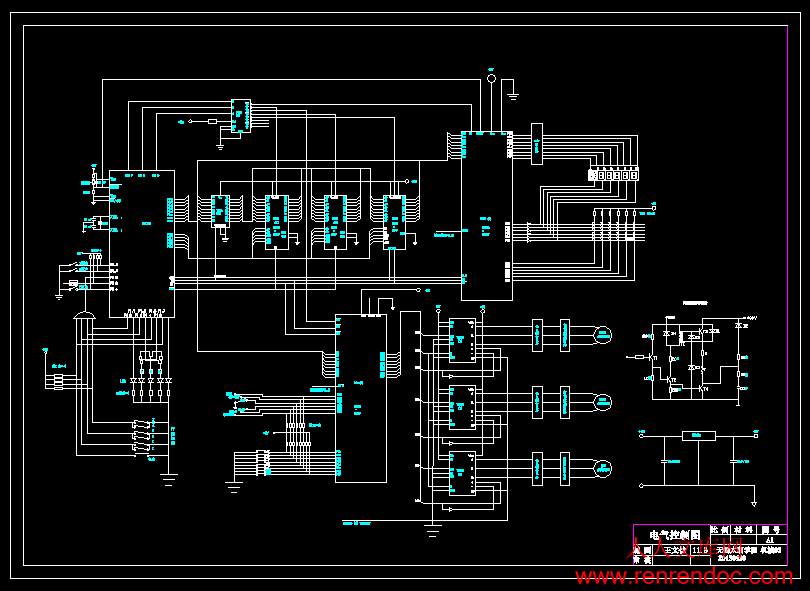数控火焰切割机的设计
48页 18000字数+说明书+开题报告+外文翻译+14张CAD图纸【详情如下】
外文翻译--数控火焰气割的基本常识.doc
数控火焰切割机的设计开题报告.doc
数控火焰切割机的设计论文.doc
毕业设计周记进度检查表.xls
04 1变径联轴器-A3图纸.dwg
04 20丝杠螺母-A3图纸.dwg
04 20滑动丝杠-A3图纸.dwg
04 24丝杠螺母-A3图纸.dwg
04 24滑动丝杠-A3图纸.dwg
04 滑台1-A3图纸.dwg
04 滑台2-A3图纸.dwg
04 电气连接图04.dwg
04 立柱-A3图纸.dwg
04 联轴器-A3图纸.dwg
04 过盈轴套联轴器-A4图纸.dwg
04 部件图1-A2图纸.dwg
04 部件图2-A2图纸.dwg
04装配图0.5-A0图纸.dwg
摘 要
本课题所设计的数控火焰切割机是一种中型切割设备,它可以很方便的对金属材料进行直线或曲线切割,可广泛应用于机械、建筑、化工、航天等行业。
首先,本文通过对火焰切割技术及数控火焰切割机的国内外研究现状的分析,对火焰切割机的总体结构进行了设计,整体采用龙门式结构,纵向、横向和垂直三个方向进给运动均选用电动机带动滚珠丝杠传动的开环控制系统。其次,由于火焰切割机切割工件时无切削力,所以纵向进给运动采用电机直接驱动来完成。最后,为了加工制造的方便还绘制了切割机的所有零部件和装配体的工程图。
关键词 数控火焰切割机,龙门式,结构设计
目 录
摘 要I
AbstractII
第1章 绪论1
1.1切割技术的种类及发展1
1.2数控火焰切割简介2
1.2.1 火焰切割及数控火焰切割技术2
1.2.2 国内外数控火焰切割技术的发展3
1.2.3 数控火焰切割机的市场及发展4
第二章 机床总体设计7
2.1总体方案的确定7
2.2控制及传动系统选用8
第三章 火焰切割机传动装置设计10
3.1螺旋传动10
3.1.1 滚珠丝杠副的工作原理及特点11
3.1.1.1纵向传动滚珠丝杠、支撑件的设计计算及电机的选择.....14
3.1.1.2横向、垂直向滚珠丝杠、支撑件的设计计算及电机的选择..21
第四章 导轨32
4.1导轨设计32
第五章 机床的维护...47
结论50
参考文献51
致谢53
附录154
附录261
附录3.......69
第1章 绪论
1.1 切割技术的种类及发展
切割是焊接生产备料工序的重要加工方法,包括冷、热两类切割,而热切割又有气体火焰切割、电弧切割、等离子切割和激光切割等各种工艺方法。目前各种金属和非金属切割已经成为现代工业生产(特别是焊接生产)中的一个重要工序,被焊工件所需要的几何形状和尺寸,绝大多数是通过切割来实现的。切割技术被广泛的应用在国民经济建设的各个领域里。
近年来,由于机械工业飞速发展的需求和国外先进技术的引进,我国切割技术无论在新工艺的开发方面,还是在新能源的利用方面都有了长足的发展。自动化、半自动化切割技术的发展,使得切割技术可以代替部分机械加工,大大提高了工作效率,还可以提高金属材料的利用率。
气体火焰切割是热切割中最早被采用和最常用的工艺方法,这种切割方法设备简单、操作方便灵活、投资费用少、切割质量好等特点。尤其是能够切割各种含曲线形状的零件和大厚度工件等一系列特点使得它自进入工业领域以来一直作为工业生产中切割碳钢和低合金钢的基本方法而被广泛采用。而本文介绍的数控火焰切割机就是在早期切割机的基础上结合近年来高速发展的微型计算机技术被广泛应用于工业领域的实际情况设计出的一种新型切割设备 。
第2章 机床总体设计
2.1总体方案的确定
数控火焰切割机是一个复杂的系统工程,它综合了计算机技术、精密机械制造、电机拖动、数字控制、焊接等多门学科,所以在设计、生产、调试、安装、维护等各环节都会遇到许多问题
1.1 适用方向
要求该设备适用面广,既可用于大型企业的下料车间,进行大型零件的批量切割,又可用于小型机械厂,进行小型零件的小批量生产。
1.2 技术水平
该设备的综合技术水平要求超过国内同类产品,接近世界先进水平。
1.3 加工精度
该设备的运行精度应超过目前的国家相关标准。
1.4 适用材料
该设备可用来切割碳钢、不锈钢、有色金属等板材。
1.5 工作方式
工作方式为连续工作。
1.6 运行速度
定位速度要求±0.012/300 mm;切割速度为1 mm~60 mm/s。
拟解决的主要问题:
中型火焰切割机设计最困难,使用时可靠性最差的要害在于轴的驱动, 可有以下几种方案以供选择:
方案一: 大型加工中心、 数控机床上常用的设计是采用长滚 动导轨与长滚珠丝杠 主要问题在长滚珠丝杠的制造成本极高, 安装上难度很大。
方案二: 采用精密齿轮齿条传动满足长行程的需要, 中捷友 谊厂为上海磁悬浮项目提供的大型加工中心就采用该方案。齿 条固定、 齿轮安装在龙门架上, 由伺服电机通过同步带减速驱动 齿轮。该方案也是目前大型火焰切割机的常用方案。当支撑龙 门架的两根导轨问距很大时, 一般采用双驱动, 可靠性不高。
…由上面两种方案的对比, 加上滚珠丝杠副的特长:1、动力更省驱动力矩仅为滑动丝杠副的1/3,具有较高的运动效率,可以更加省电。2、高精度的保证滚珠丝杠副都是由高水平的机械设备连贯生产出来的,制作精度更高。3、微进给可能滚珠丝杠副由于是利用滚珠运动,所以启动力矩极小,不会出现滑动运动那样的爬行现象,能保证实现精确的微进给。4、无侧隙、刚性高滚珠丝杠副可以加预压,由于预压力可使轴向间隙达到负值,进而得到较高的刚性。5、高速进给滚珠丝杠副由于运动效率高、发热小,所以可实现高速进给(运动)。
可得出:在追求设计出一台高精度,高性能数控机床,方案一比较好。
2.2控制及传动系统选用
数控火焰切割机的主要技术参数
纵向导轨长度/m 6
跨距/m 2
有效切割宽度/m 1.6
有效切割长度/m 5
切割厚度/mm 6~160
切割精度/mm ±0.5
最高行动速度,m.min 15
割炬组数 单割炬
割炬升降范围/mm 800
定位精度/mm ±0.012/300
根据本紧急系统定位精度的要求,应选用全闭伺服系统。从产品目录中查得伺服电机的最高转速为或2000r/min。如果伺服电机通过联轴节与丝杠接,即i=1。工作台快速进给的最高速度要求达到。取电机的最高转速


 川公网安备: 51019002004831号
川公网安备: 51019002004831号